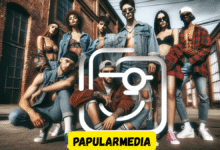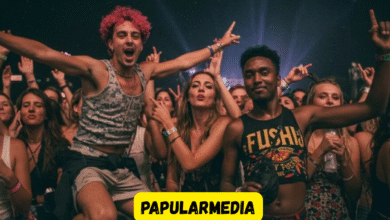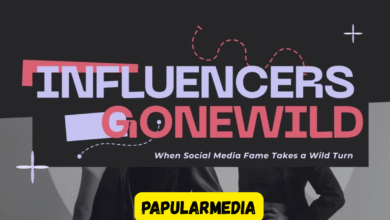Influemcers gonewild: Exploring the Rise, Impact, and Controversy of Digital Fame

The Phenomenon of “Influemcers Gonewild”
Influemcers gonewild In the rapidly evolving world of digital content, the term “influemcers gonewild” is gaining increasing attention. A likely typo or variant of “influencers gone wild,” it has become a viral phrase used to describe the unpredictable, unfiltered, and often controversial behaviors of internet personalities who deviate from the polished image traditionally associated with influencer culture. These individuals break boundaries, often going viral for shocking antics, explicit content, or unexpected online breakdowns.
The social media landscape today rewards visibility, attention, and virality. While many influencers build their brand on authenticity and engagement, there is a growing subset of content creators who leverage controversy and chaos to maintain relevance. The phrase “influemcers gonewild” captures this cultural moment, where boundaries between fame and infamy are blurred, and online antics often eclipse meaningful content.
The Changing Nature of Influencer Culture
Influencers were once perceived as modern-day celebrities who earned trust by sharing relatable, curated snippets of their lives. Over time, however, the influencer ecosystem has become saturated and competitive, pushing many to extremes to stand out. Influemcers gonewild have moved beyond beauty tutorials and lifestyle vlogs to more provocative, attention-seeking content. The pressure to remain in the spotlight has created a space where missteps, meltdowns, and outrageous behaviors are not only common but sometimes encouraged by fan engagement.
This evolution is partially fueled by social media algorithms that reward high engagement—often driven by controversy. As a result, influencers have discovered that “going wild” not only garners views but often enhances their visibility in a saturated market. This shift has contributed to the rise of influencers who prioritize shock value over substance.
Social Media Platforms as Enablers
The very platforms that helped create influencer culture also enable the “gone wild” behavior. Whether it’s Instagram, TikTok, YouTube, Twitter, or newer platforms, all are structured to reward content that sparks reaction. The more dramatic, outrageous, or scandalous the content, the more likely it is to trend.
Some influencers have taken this to the extreme by deliberately pushing the boundaries of what is acceptable on these platforms. In some cases, this involves adult content, emotionally charged rants, or public feuds. Platforms struggle to manage such content due to the sheer volume of uploads and the gray area between expression and violation of community guidelines.
This environment creates fertile ground for the rise of influemcers who defy conventional boundaries, often celebrating their own controversies as markers of independence or authenticity.
The Role of Audiences in Shaping Behavior
Audience behavior significantly influences how influencers act. As followers engage more with scandalous or dramatic content, it sends a clear message: chaos is profitable. The parasocial relationship between influencers and their audiences allows followers to feel invested in every aspect of their lives—from relationships to feuds and personal breakdowns.
Many followers are attracted not just to the lifestyle an influencer presents but also to the drama they generate. This dynamic has led to an ecosystem where influencers feel compelled to manufacture conflict or expose their private lives for content. In essence, the audience becomes both consumer and instigator, co-creating the environment that fuels “influemcers gonewild.”
Mental Health and the Pressure to Perform
The lifestyle of an influencer may seem glamorous, but it often comes at a cost. The constant need to remain visible, relevant, and engaging places immense pressure on content creators. The performance never stops, and influencers must be “on” at all times.
This pressure can lead to mental health issues such as anxiety, depression, burnout, and identity crises. When influencers crack under pressure, it can manifest as erratic behavior, public meltdowns, or shocking content—contributing to the “gone wild” image.
Unfortunately, instead of receiving compassion, influencers who display emotional vulnerability often become memes or the subject of ridicule. This cycle contributes to further stress and can push them toward more extreme behavior as a coping mechanism or cry for attention.
Monetization and the Incentive for Chaos
Monetization is at the heart of influencer behavior. Content that goes viral—whether positive or negative—can translate into brand deals, increased followers, and more ad revenue. Influencers who go wild are often rewarded with attention and financial gain.
In some cases, influencers intentionally stage controversial content to boost their numbers. From fake relationships to planned drama, the strategy is clear: manipulate emotions and dominate the conversation.
This model undermines the original premise of influencer culture, which was based on trust and relatability. Instead, it replaces authenticity with spectacle, leaving both influencers and audiences in a cycle of escalating outrageousness.
The Blurring of Public and Private Life
The digital age has all but obliterated the line between public and private. Influencers build their brand by giving audiences access to their lives. However, this constant exposure can backfire. Every argument, misstep, or lapse in judgment becomes content.
When influencers “go wild,” it is often a reaction to the invasive scrutiny of their personal lives. In other cases, it is a strategic decision to blur the line further, capitalizing on the voyeuristic tendencies of online audiences.
Either way, the result is a toxic feedback loop where the influencer loses control over their narrative and is defined by their most dramatic moments.
Society’s Fascination with Downfall and Redemption
There is a long-standing cultural fascination with watching people rise and fall. Influencers are no exception. Stories of influencers going off the rails attract enormous public interest. But what follows is often a redemption arc, where the same influencer makes a comeback, rebranding themselves and regaining public sympathy.
This cycle—fall from grace followed by reinvention—is common in celebrity culture but is now accelerated in the influencer space due to the speed of social media. Influencers understand this rhythm and sometimes play into it knowingly, creating drama they can later apologize for and profit from again.
Ethical Concerns and the Responsibility of Influence
The term “influencer” carries weight because it implies the power to affect others’ thoughts, behaviors, and decisions. When influencers go wild, the consequences can ripple out to their followers, many of whom are impressionable young people.
Irresponsible behavior—promoting unhealthy lifestyles, dangerous stunts, or offensive content—can have real-world impacts. Influencers who cross the line risk doing harm, even if unintentionally. This raises important ethical questions about the responsibilities of content creators and the platforms that host them.
It also calls into question the role of brands and sponsors, many of whom continue to support controversial influencers as long as their engagement numbers remain high.
The Future of Influencer Culture
The “influemcers gonewild” trend signals a pivotal moment in influencer culture. As audiences become more aware and critical of the content they consume, a shift may be on the horizon. Some users are already seeking more meaningful, educational, or creatively fulfilling content.
At the same time, the allure of drama and virality remains strong. As long as platforms reward sensationalism, some influencers will continue to embrace chaos as a strategy.
Ultimately, the future of influencer culture will depend on the choices of content creators, platforms, and audiences. Whether the focus returns to authenticity or continues down the path of spectacle remains to be seen.
FAQs About “Influemcers Gonewild”
What does “influemcers gonewild” mean?
The term appears to be a misspelled version of “influencers gone wild” and refers to social media personalities who exhibit unpredictable, controversial, or chaotic behavior, often for the sake of attention or virality.
Why do influencers behave outrageously online?
Many influencers feel pressure to remain relevant in a saturated market. Outrageous behavior often generates more engagement, views, and monetization opportunities than regular content.
Are there consequences for influencers who go too far?
Yes, some influencers face backlash, loss of sponsorships, or bans from platforms. However, others may gain even more popularity and capitalize on the controversy.
How do audiences contribute to this trend?
Audiences play a significant role by engaging more with dramatic or scandalous content, which encourages influencers to continue or escalate such behavior.
Is this trend harmful to viewers?
It can be, especially for young or impressionable viewers. Normalizing erratic or irresponsible behavior online may lead to unhealthy perceptions and choices.
Can this trend be reversed?
A cultural shift among viewers toward valuing authenticity and Influemcers gonewild content could help reverse the trend. Platform policies and ethical branding practices also play a role.
What should influencers keep in mind?
Influencers should be aware of the impact they have and strive to balance entertainment with responsibility. Long-term credibility often matters more than short-term virality.





